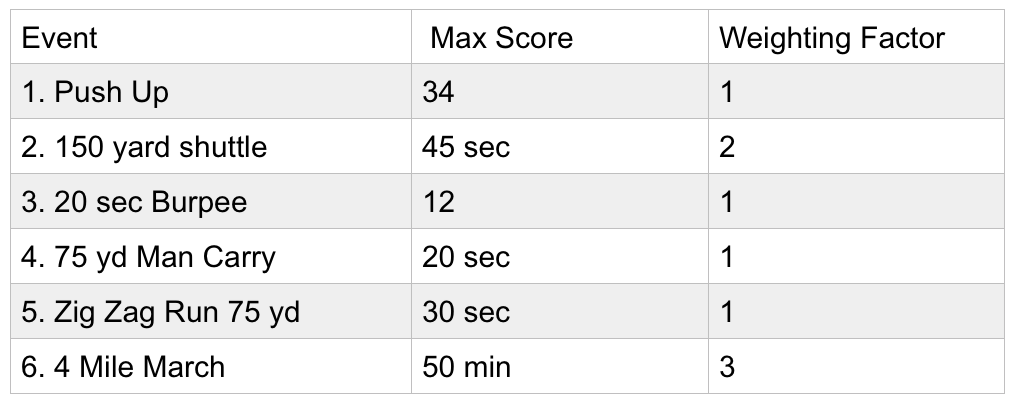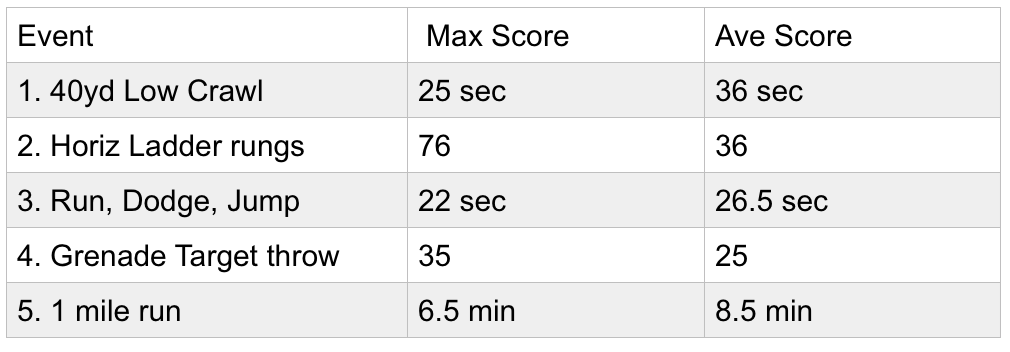
By Rob Shaul
Every couple years or so we hear about US Army efforts to study and possibly replace the APFT as it’s semi-annual fitness assessment.
The following timeline following the history of Army fitness testing and development of the APFT was gleaned from “History of the United States Army Physical Fitness and Physical Readiness Testing,” by Joseph Knapik, ScD, and Whitfield East, PhD, published in the April-June, 2014 US Army Medical Department Journal.
Couple highlights:
- 1906 was the first time fitness training was made mandatory, and it included weekly 12 mile marches for infantry and 30-mile rides for cavalry.
- First Army fitness test developed in 1920 following WWI
- Mandatory, Army-wide fitness testing began in 1963
- By 1973 the Army was suffering from “test proliferation” and had at least 7 different fitness assessments for various populations, schools, etc.
- The current APFT was developed and refined in 1980-82
- Proposal to change the APFT was shelved in 2012 and a study commissioned through TRADOC to revise the APFT based on combat fitness demands was begun
- TRADOC is scheduled to brief senior Army leadership on the study results summer/fall 2015.
Date & Event:
1852 West Point (USMA) implemented first physical fitness program loosely based on the Prussian Turnerien model. Fitness program was built around gymnastics, calisthenics, swimming, and fencing.
1858 First Fitness Assessment proposed for USMA Cadets: 15-foot wall climb, 15 hands high horse vault (5 feet), 10-foot ditch leap, 1 mile run under 8 minutes or 2 mile run under 18 minutes, 4.5 mile walk in 1 hour, 3 mile ruck in 1 hour with 20 pound ruck, arms, and equipment.
1895 USMA hires first Professional physical educator, John Koehler, who served as “Master of the Sword” until 1923. Under Koehler’s influence, system physical training was initiated throughout the US Army.
1892 Koehler’s training manual, “A Manual of Calisthenic Exercises” published and becomes the first Army-wide fitness training manual.
1906 First required, Army-wide, physical training established. General Order No. 44 required weekly infantry 12-mile rucks, and 18-mile movements for horse-mounted artillery and cavalry. The order also established a 3-day, 90-mile riding test for the cavalry and horse-mounted artillery and a 45-mile ruck march test for the infantry.
1901-1908 President Theodore Roosevelt, a strong proponent of rigorous physical exercise, mandates the 3-Day, 90-mile horse ride for all field officers, and those who couldn’t complete it be subject to “appropriate action.”
1920 World War I leads to the book, “Mass Physical Training for Use in the Army and Reserve Officer Training Corps.” Book proposed a six-event, “Individual Efficiency Test”:
- 100 yard Sprint in 14 Seconds
- Running Broad Jump – 12 Foot Standard
- 8 Foot Wall Climb
- 30-Yard Grenade Throw
- Obstacle course Run
1941 Field Manual 21-20 published – first field manual dedicated to physical training. Manual includes a 4-event fitness performance test:
- 100 yard Sprint in 14 sec
- Running High Jump, 3’, 9” min
- Running Broad Jump, 12 feet min
- Push Ups – 20 Reps min.
1942 In preparation for war, Army publishes a weighted, scored “Army Grand Forces Test” – Six Events aimed to test Circulo-respiratory endurance, velocity, muscular endurance and mesomorphic build.

1942 War Department Pamphlet establishes the scored “Physical Efficiency Test Battery” of 7 events:

1946 War Department updates the 1942 test and drops the Man Carry and Burpees. Puts a 2-min time limit on the situps, and scales the scoring according to age.
1950 Army changes scoring the Physical Efficiency Test and adds a “Physical Achievement Test” administered to “combat type” units. The event had 4 events:

1961 Essential military skills defined as “running, jumping, dodging, climbing, traversing, vaulting, carrying, balancing, falling and swimming.” Both the Physical Efficiency Test and the Physical Achievement Test were replaced with the scored “Physical Combat Proficiency Test.”

1963 Fitness testing made mandatory for all Army personnel 40 years old and young, including women.
1965 Semi-annual fitness testing made mandatory for all Army personnel 40 years old and younger. Testing also required for BCT, Advanced schools and leadership training lasting 8 weeks or more.
1969 Physical Combat Proficiency Test made the standard test and scoring revised, but additional tests were added including the “Minimum Fitness Test,” “Airborne Trainee Physical Fitness Test,” and “Inclement Weather Test.”
1973 Test proliferation continued and 7 separate assessments were made part of the “Army Physical Fitness Evaluation.” There were tests for operational units, combat support units, and inclement weather tests. Others included the Basic Physical Fitness Test, Advanced Physical Fitness Test, and the Minimum Physical Fitness Tests. Special tests were also sued for Ranger or SOF training and Airborne school. One important event change was the inclusion of a 2 mile run for the Advance PT test.
1980 2 Current APFT events standardized (2 min Push ups and situps, and 2-mile Run)and semi-annual testing made mandatory. Scores adjusted based on age and gender.
1985 Test officially named the “Army Physical Fitness Test” (APFT) and soldiers authorized to take the test in shorts, t-shirt, and running shoes.
1992 APFT scoring changed to the current system, and scores added for up to 52 years of age.
2003 Attempt to revise the APFT included these events: Standing long jump, 1-minute “power squat”, 1-minute heel-hook, 12x 25 yard shuttle run, 1-minute push up and 1-mile run. The 2003 proposal was not implemented, partly due to concerns about safety and administering some test items.
2010 Test of physical capacity (Army Physical Readiness Test) and functional capacity (Army Combat Readiness Test) proposed to replace the APFT.
APRT events were standing long jump, 1-minute rower, 60-yard shuttle, 1 minute push up and 1 mile run.
The ACRT was a timed, obstacle course run similar to obstacle courses from the 1920s and 1940s. It included a 400-meter run with weapon; an obstacle course with low hurdles, high crawls and over-under obstacles; a 40-yard casualty drag; a 40-yard run with ammo cans atop a balance beam; point, aim and move drills; a 100-yard ammo can shuttle sprint; and a 100-yard agility sprint — was thrown out due to the cost of materials.
Both tests were proposed to be taken one time each year.
2012 Plans to implement the APRT and ACRT stopped.
Army leaders expressed concerns about the scientific basis for the tests, and feasibility of the ACRT, including cost.
After seeing the results of a 2011 feasibility study, the Army shelved the APRT and ACRT in 2012 and ordered a comprehensive study of Army Physical Readiness testing to includes (1) systematic literature review, (2) linking fitness and functional tests to soldering tasks, and (3) validating the test against soldiering tasks. Primary study is due to be completed in early 2015.
Part of this study is to determine what is required for warrior tasks, battle drills, and common soldier tasks. The aim of the study is to determine what it takes physically to perform the tasks troops do every day. Research includes an experiment on 500 soldiers studying how they perform combat tasks.
The study is expected to influence the creation of a physical aptitude test, or a series of tests, that could drastically alter how soldiers are assigned jobs.
2015 Training and Doctrine Command (TRADOC) scheduled to brief senior Army leaders on the results of the study begun in 2011 to replace the APFT.
You Might Also Like MTI’s APFT Training Plan
